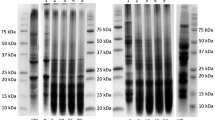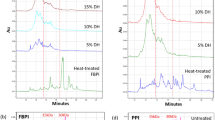Abstract
Vegetable proteins are available to the food industry in various forms, such as flours, concentrates, isolates, and TVP (textured vegetable protein). However, the functional properties of these products are not always optimal and need improvement for certain applications. In recent years it has been demonstrated that a limited enzymatic hydrolysis offers a convenient and specific means of improving certain functional properties of vegetable proteins. The hydrolysis reaction is controlled by the degree of hydrolysis (DH) which is defined as the percentage of peptide bonds cleaved. Under neutral or slightly alkaline conditions, DH can be monitored continuously by the pH-stat technique, since the amount of base necessary to maintain a constant pH is proportional to DH. The reaction is terminated at a preset DH-value to obtain the desired properties of the hydrolysate.
Protein products from soya bean, faba bean, and potato were hydrolysed to DH 0%, 3% and 5%, and certain functional properties (iso-electric solubility, emulsification capacity, whipping expansion, and foam stability) were evaluated. The general picture observed is an increase, often pronounced, in these four properties with increasing DH — however, there are also distinct differences between the protein sources as well as between the different forms of a particular protein. This work demonstrates that protein sources indigenous to Europe are fully comparable to soya protein with respect to potential functional uses.
Similar content being viewed by others
References
Adler-Nissen J (1977) Enzymatic hydrolysis of food proteins. Process Biochem 12(6):18–23, 32
Adler-Nissen J (1978) Enzymatic hydrolysis of soy protein for nutritional fortification of low pH-food. Ann Nutr Alim 32:205–216
Adler-Nissen J, Sejr Olsen H (1979) The influence of peptide chain length on taste and functional properties of enzymatically modified soy protein. ACS Symp Ser 92:125–146
Adler-Nissen J (1981) Limited enzymic degradation of proteins — a new approach in the industrial application of hydrolyses. J Chem Technol Biotechnol 32:138–156
Bobalik JM, Taranto MV (1980) The effect of enzymic modification on the foaming, water absorption and baking quality of defatted soy flour. J Food Technol 15:637–646
Eriksen S, Fagerson IS (1976) Flavours of amino acids and peptides. Int Flavours Jan–Feb 1976:13–16
Gunther RC (1979) Chemistry and characteristics of enzyme-modified whipping proteins. J Am Oil Chem Soc 56:345–349
Holm F (1980) A new system for the production of starch and protein from potato. Stärke 32:258–262
Holm F, Eriksen S (1980) Emulsifying properties of undenatured potato protein concentrate. J Food Technol 15:71–83
Horiuchi T, Fukushima D, Sugimoto H, Hattori T (1978) Studies on enzymemodified proteins as foaming agents: effect of structure on foam stability. Food Chem. 3:35–42
Novo Industri A/S (1978) IB-102: Hydrolysis of food proteins in the laboratory. Bagsvaerd, Denmark
Novo Industri A/S (1980) B-207: Alcalase ® 0.6 L. Gagsvaerd, Denmark
Puski G (1975) Modification of functional properties of soy proteins by proteolytic enzyme treatment. Cereal Chem 52:655–664
Sejr Olsen H (1978) Continuous pilot plant production of bean protein by extraction, centrifugation, ultrafiltration and spray dyring. Lebensm -Wiss u -Technol 11:57–64
Sejr Olsen H (1980) A survey on recent developments in industrial processing ofVicia faba protein. In: Bond DA (ed),Vicia faba. Feeding Value Processing and Viruses. Brussels and Luxembourg: ECSC, EEC, EAEC, pp 233–255
Sejr Olsen H, Adler-Nissen J (1981) Application of ultra- and hyperfiltration during production of enzymatically modified proteins. ACS Symp Ser 154:133–169
Zakaria F, McFeeters RF (1978) Improvement of the emulsification properties of soy protein by limited pepsin hydrolysis. Lebensm -Wiss u -Technol 11:42–44
Author information
Authors and Affiliations
Rights and permissions
About this article
Cite this article
Adler-Nissen, J., Eriksen, S. & Olsen, H.S. Improvement of the functionality of vegetable proteins by controlled enzymatic hydrolysis. Plant Food Hum Nutr 32, 411–423 (1983). https://doi.org/10.1007/BF01091198
Issue Date:
DOI: https://doi.org/10.1007/BF01091198




